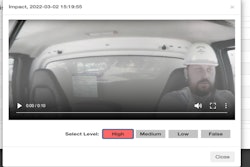Netradyne customer SDS Recycling offers a $25 gift card each week for the driver with the highest GreenZone score – a system on the Driveri platform that captures and analyzes driver behavior like speed and following distance, among other things.
It’s an incentive that has driven better safety for its fleet.
Netradyne’s scoring system is based on “science of change,” and one of the its principles is positive reinforcement. A study at a New York State hospital where the goal was to increase the frequency at which medical staff washed their hands before entering patient rooms found that staff knowing they were being recorded by cameras was not enough to change behavior. With the addition of an electronic board in the hallway of the unit that gave employees a positive message and displayed the shift’s current hand hygiene score, compliance rates reached 90% within four weeks.
Austin Schmidt, director of performance marketing at Netradyne, said that’s operant conditioning where people are wired to adjust their behavior, often even subconsciously, to obtain the outcomes we want.
That’s one key factor in transforming safety from a cost center to a cost saver, Schmidt said during a recent Truckload Carriers Association webinar.
“I really love this quote from Charlie Munger, a Warren Buffett business partner, that explains operant conditioning: ‘Show me the incentives, and I'll show you the outcome,’” Schmidt said. “Cameras or most other technologies on their own will not automatically reduce your operational costs. But the good news is that leveraging two key principles of the science of change within your organization will.”
The other principle is instant feedback. A study called Timing Matters: The Impact of Immediate and Delayed Feedback on Artificial Language Learning assessed the impact of immediate versus delayed feedback on learning a second language and found that even a two- to three-second delay reduced a student's ability to learn from their mistakes by 21%.








